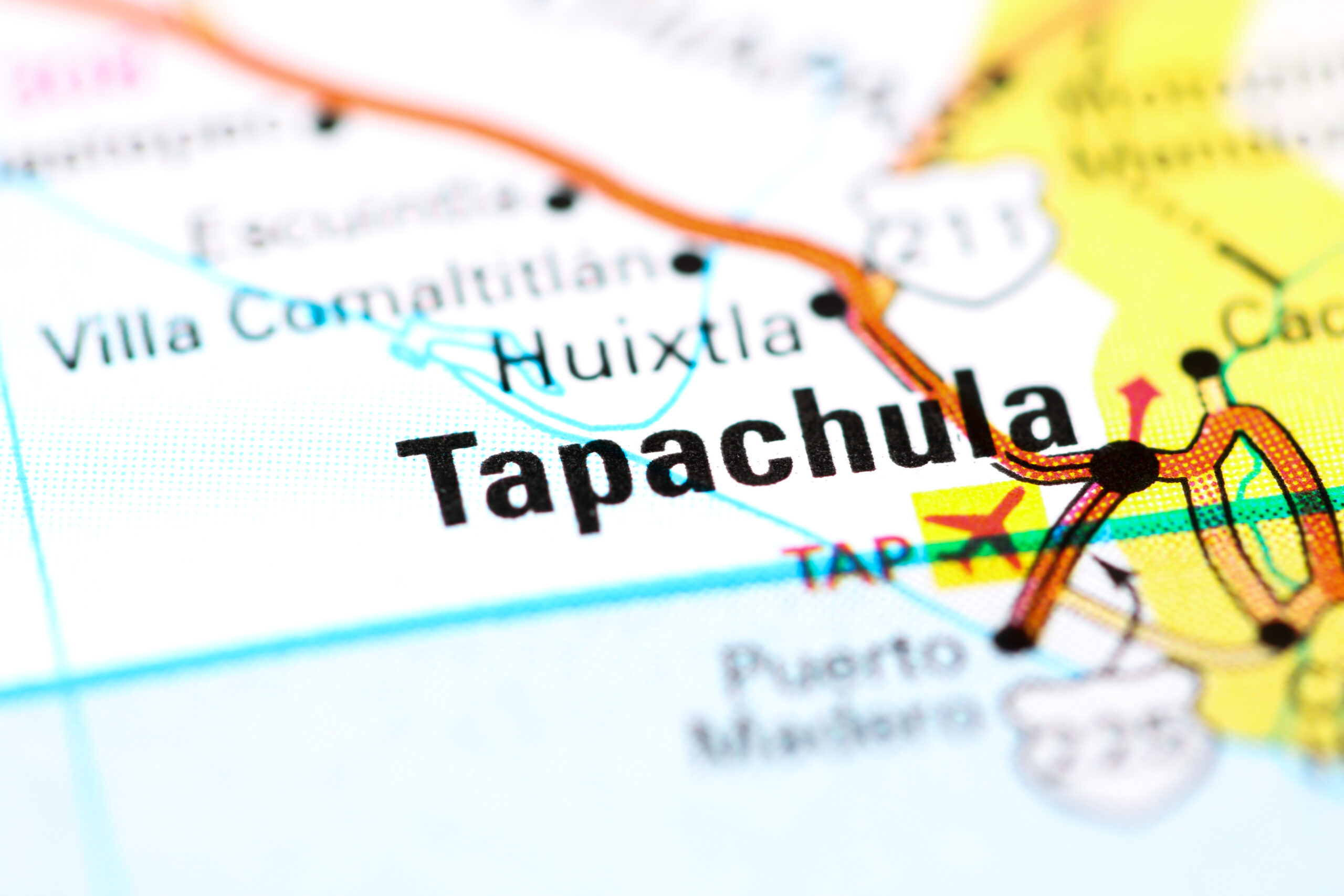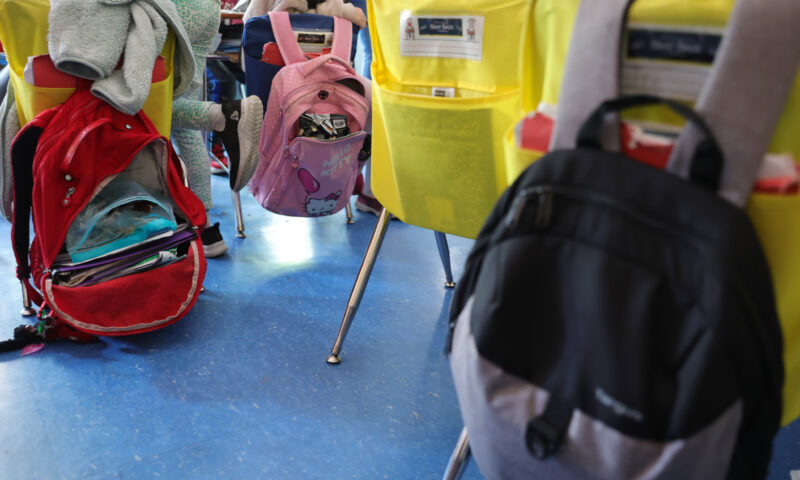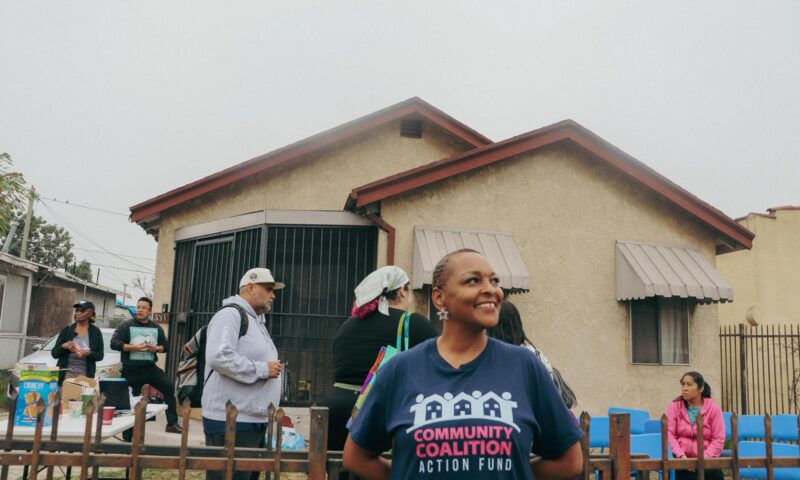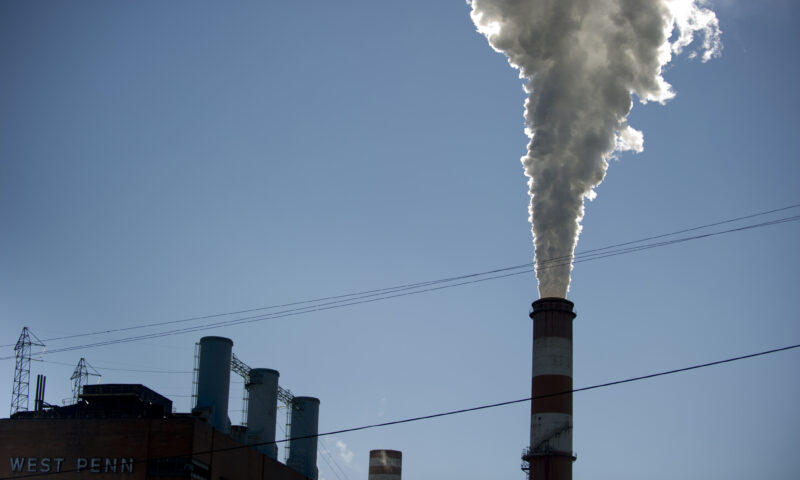This story is the first in a three-part series.
On a hot, stormy Monday afternoon in September, a Mexican government van labeled Gobernación pulled up to a series of large tents set up in a parking lot in Tapachula, a city near the Guatemalan border.
One by one, men, women and children, many wearing clothing received in U.S. government custody, stepped out of the van and followed Mexican immigration officials inside a tent with rows of chairs arranged as though for a lecture. None of the new arrivals was wearing shoelaces, removed so those in U.S. custody don’t use them to attempt suicide.
From beneath a colorful canopy, the voice of a nearby vendor called out his wares, which included cigarettes and shaved ice. A sign hanging on the fence around the tents read “México te abraza,” or “Mexico embraces you.”
The immigration official driving the van said he would return to the airport to pick up more people. In total, about four vans full of people arrived at the tents that afternoon.
Vans like his, which belong to the Secretaria de Gobernación, the country’s equivalent to the Department of Interior, which oversees Mexico’s immigration agency, have long transported migrants in the custody of the Mexican government around Tapachula.
But the people riding in the Gobernación van on this late September afternoon had already been deported, flown to a city more than 1,100 miles from the closest U.S. border crossing.

A Gobernación van transporting deportees from the airport arrives at a temporary reception center set up by the Mexican government in a sports stadium parking lot. Photo: Kate Morrissey.
Under the Trump administration, the U.S. government has been deporting Mexican nationals by plane directly to Tapachula and Villahermosa, two small cities in Mexico’s southern border states, far away from the country’s longstanding infrastructure in the north to receive deportees. It’s part of a larger strategy implemented by administrations from both parties to push the U.S. border further south to stop those trying to reach its soil.
Many people recently deported on flights told Capital & Main that the U.S. government had taken their phones, and they struggled with the little money that they had to find their way out of being stranded in a city they did not know.
“In reality, they tell you one thing, and then another thing happens,” said one bewildered woman who had just been deported to Tapachula with no way to contact her relatives.
The Department of Homeland Security and Immigration and Customs Enforcement did not respond to a request for comment.
Mexico has set up reception centers in each city, but the support they provide is limited, and there’s little to no resources in the area to help deportees once they leave those temporary respites.
Miguel Hernández, head of the Tapachula office for the Coalition for Humane Immigrant Rights, or CHIRLA, said that those who work with migrants in the city are used to addressing the needs of people entering Mexico from the south with plans to continue to the U.S. border and of those trying to seek asylum in Mexico.
“What we can say is that up to this moment, a solid infrastructure does not exist (for Mexican deportees),” Hernández said in Spanish.
Tapachula, which activists have long called an open air prison for migrants, is in the state of Chiapas, the poorest in the country. The U.S. State Department lists the region at level three — reconsider travel — because of cartel activity there. Kidnappings of migrants have grown increasingly common in the state.
Adding to the challenges for the recently deported, the deportation flights arrive seemingly at random and with little notice, so humanitarian workers struggle to monitor and respond.
In September, the Trump administration sent nine flights to the southern Mexico cities, according to a report from Human Rights First ICE Flight Monitor. In August, a record high of 72 flights arrived.
According to the Mexican government, the U.S. deported nearly 25,000 people there by plane so far this year, mostly to Tapachula and Villahermosa, with a smaller number to Mexico City.
Expanding the Border
Deporting Mexicans via flights to the southern end of their country is part of a larger, ongoing effort among recent presidents to move the U.S. border further south and stop migration well before people reach U.S. soil, according to Adam Isacson of the Washington Office on Latin America, a human rights group.
“The increased flights to Tapachula are a harsh and classic example of that kind of externalization,” Isacson said.
The U.S. began deporting Mexicans by flight in 2012 under then-President Barack Obama. But those flights went to large, central cities, including the capital.
Then-Immigration and Customs Enforcement Director John Morton told the Associated Press at the time that the flights “will better ensure that individuals repatriated to Mexico are removed in circumstances that are safe and controlled.”
In 2020, with the onset of the pandemic, the Trump administration began a border policy called Title 42 that allowed officials to expel migrants of other nationalities to Mexico without reviewing their asylum claims. These expulsions were not technically deportations — they didn’t mark the person’s immigration record in the same way — but they felt like deportations to the people returned.
In 2021, under then-President Joe Biden, the federal government began using flights to Tapachula and Villahermosa to expel people further from the border so they wouldn’t try crossing again.
At the same time, the number of migrants grew in the region because Mexico sent its National Guard to support its own immigration agency in stopping people from traveling north. Many of the enforcement tactics looked like the ones used along the southern border of the U.S., including checkpoints and long-term detention facilities.
That year, the Mexican government used the space around the Estadio Olímpico in Tapachula as a migrant processing area. Now, that soccer stadium has become the reception area for deportees.
The Trump administration began sending Mexicans on deportation flights to Tapachula and Villahermosa in February, according to the ICE Flight Monitor.
While flying to southern Mexico directly might be helpful to people originally from that part of the country, it does not appear that officials in the U.S. are selecting people for the flights with that in mind.

Tapachula International Airport is the southernmost airport in Mexico. Photo: Kate Morrissey.
Human rights observers and humanitarian workers who have gone to meet the flights said most of the people they’ve spoken to are from central or northern Mexico. Some have been in the U.S. for so long that they don’t have family or friends anywhere in the country, according to Daniel De León Gutiérrez of Jesuit Refugee Service.
The deportees arrive chained at the wrists, waist and ankles, which many said makes them feel less than human.
“They arrive with all of this shock to Tapachula, and add to this that they arrive in Tapachula, which is a place they have never visited in their lives,” said Hernández, who works with CHIRLA. “They don’t know it. They don’t know where they are.”
In Tapachula, a city of about 350,000 people, more than 60% of the population lives in poverty, according to data from the Mexican government. The average monthly income there is just over $5,000 pesos per month — the equivalent of about $275 in U.S. dollars. That’s less than half of the national average for monthly income in Mexico.
The tropical climate means thunderstorms flood the roads almost daily in the summer, and leafy green vegetation thrives, making bananas and coffee among the region’s main exports.
The city has less than a half-dozen migrant shelters. By comparison, Tijuana has around 30.
Hernández said deporting people by plane to the region is clearly intended as a punishment.
“They’ve told us, ‘They sent us here because they don’t want us to enter again,’” Hernández said. “I think there’s a rationale of punishing people more and more, to leave them alone, stranded, without support networks.”
Confiscated Phones
A couple of hours after they arrived on this rainy Monday afternoon, most of the newly deported people returned to the Gobernación vans for a ride to a bus station where they could buy tickets to continue their journey back across Mexico. Many said they were from north of Mexico City and had crossed the border recently either to request asylum or to try to find work.
U.S. Border Patrol agents had confiscated their phones and deported them without any way to communicate with loved ones, they said. Some didn’t have any numbers memorized, so they couldn’t even use a borrowed phone.
Capital & Main is not identifying the deportees due to ongoing concerns about safety or retaliation.
Hernández said it sounded like Border Patrol was taking away the phones as punishment.
Customs and Border Protection did not respond to a request for comment.
Many said they felt they’d been tricked into giving up their phones. One woman said an agent asked to review her phone, and she said she handed it over, unlocking it willingly, believing she would get it back once he finished. Instead, he told her he was keeping it as evidence, she said.
Another woman said that an agent threatened to send her to jail if she didn’t give him her phone. She said she’d crossed the border with her husband after the U.S. denied their visa applications to visit her father, who she said is a U.S. citizen and is dying from cancer. Her husband was still somewhere in U.S. custody, she said, since border officials separated them.
“They treat us worse than criminals,” she said. “They humiliate us.”

A woman from Tijuana waits with her two daughters at the OCC bus station in Tapachula. She said U.S. officials made them remove their shoelaces when they were apprehended crossing the border. Photo: Kate Morrissey.
One woman who was processed by the Yuma Sector of Border Patrol in Arizona received paperwork informing her that her phone had been seized, and that to get it back she would have to make a request by calling the asset forfeiture office within 30 days. Otherwise, the phone would be destroyed, the document says. But neither she nor others interviewed by Capital & Main seemed to understand what they needed to do to recoup their phones.
A few of the people without phones said they had been able to call family members while at the reception center at the Estadio Olímpico.
“But it’s not the same,” one woman lamented.
She wanted to be able to stay on the phone with her family while she figured out what to do next.
As they waited at the station for the next bus to Mexico City, several women walked to a nearby Oxxo convenience store to buy cheap phones. When they returned, their faces lit up as they spoke to their families.
Fined
A young man stood toward the end of the line of deportees to buy a bus ticket, his arm in a sling.
He said that when Border Patrol agents apprehended him in Texas, one of them shocked him with a Taser, knocking him unconscious. He woke up in a hospital with a concussion and injured arm, he said.
The hospital released him about three days later, he said, and agents promptly deported him on a plane to Tapachula.
As he spoke, he paused every now and then, and expressions of confusion that seemed to be from the lingering concussion appeared on his face.
A friend he met on the journey back to Mexico encouraged him to try to seek justice for what happened to him, but he said he didn’t know how to begin to pursue that from Mexico.
In fact, the U.S. government has told him that he owes it money. He was one of many deportees who received a $5,000 fine for crossing the border.
Though one man’s paperwork said he owes $250, most, including the man with the sling, had documents that set the fine at $5,000. In October, the U.S. embassy announced that border officials would begin fining border crossers $5,000, but these migrants crossed in September, well before the announcement.
Gilberto Martínez, the administrator for Casa del Migrante, a migrant shelter in Tijuana, said the day after the announcement that he had not yet seen deportees pass through his shelter with those notices.
The documents include a sheet instructing the deportees to pay either online, by QR code or by mail. It is not clear what will happen if they do not pay the fines, but the documents warn that another apprehension crossing the border could lead to up to a year in jail.
No Asylum, No Other Option
Among those trying to decide their next move was a mother traveling with her two daughters who said her husband had been killed in Tijuana and that she had fled death threats and sought asylum in the U.S.
She and other asylum seekers said that border officials told them the U.S. didn’t have asylum anymore and deported them without any kind of screening.
“They were looking for my children because of their age, and because of that I — never in my life had I gone there (to the U.S.), but now in this circumstance, one looks for refuge, help,” the woman said.
She sat at the bus station for hours, trying to decide where to go — and how to get there.

A mother and son who were deported to Tapachula after attempting to seek asylum buy bus tickets home. The mother was worried about her safety but didn’t know where else to go. Photo: Kate Morrissey.
At the reception center, government officials had handed out prepaid cards with $2,000 pesos or roughly $100 in dollars.
Most of the deportees used the money to buy bus tickets home. But one ticket to Mexico City from Tapachula costs more than $1,700 pesos, and the Tijuana woman with two daughters received only one card. She didn’t have the funds to go home.
Despite her fears, she decided to try to find a way back to Tijuana because at least there she knew where she was, she said. Another deported woman borrowed a phone to call her U.S. relatives, who wired her money. The women spent the night in a hotel near the bus station and bought tickets to Mexico City the following morning.
“We see that even though there’s this economic support from the program México Te Abraza, it doesn’t cover all of the needs of these people,” Hernández said of Mexico’s efforts to welcome and support deported citizens.
The Secretaria de Gobernación did not respond to a request for comment.
The woman and her daughters spent several days in Mexico City before finding someone to give them a ride to Tijuana. Once there, they hid with someone she knew rather than going home. She said she has weighed trying to cross onto U.S. soil again because she doesn’t know what else to do.
She’s not the only one. A woman who said she crossed to find work to pay for medical care for her mother and daughter said she’s thinking about making another attempt. A man who requested asylum with his sister and her children said he’s trying to find out if he can still come to the U.S. on a temporary work visa.
Two days after they arrived in Tapachula, another plane landed carrying deportees.
Copyright 2025 Capital & Main.
This story was supported with a Charles M. Rappleye grant via the Los Angeles Press Club.


 The SlickNovember 14, 2025
The SlickNovember 14, 2025
 Latest NewsNovember 11, 2025
Latest NewsNovember 11, 2025
 The SlickNovember 12, 2025
The SlickNovember 12, 2025
 Column - State of InequalityNovember 13, 2025
Column - State of InequalityNovember 13, 2025
 Latest NewsNovember 19, 2025
Latest NewsNovember 19, 2025
 Latest NewsNovember 18, 2025
Latest NewsNovember 18, 2025
 Latest NewsNovember 17, 2025
Latest NewsNovember 17, 2025
 The SlickNovember 18, 2025
The SlickNovember 18, 2025





